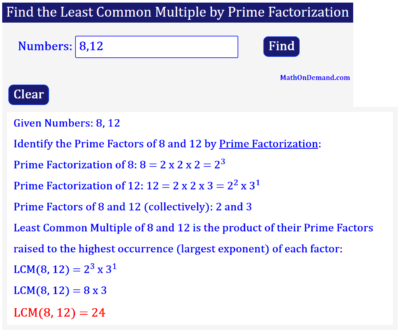As illustrated below and by other available solutions, this application will find the Least Common Multiple (LCM) of two or more numbers by Prime Factorization.
The Least Common Multiple (LCM) of a set of positive integers or natural numbers could be found by Prime Factorization of each positive integer or by listing the multiples of each positive integer. When the numbers are larger than the multiples found in a multiplication table, finding their LCM by Prime Factorization is recommended. The application above will return the LCM by Prime Factorization. Each number entered should be separated by a comma as illustrated below.
Students in the 7th grade should be able to find the LCM of two natural numbers less than 12 under Common Core standards. Finding the LCM of a set of numbers by prime factorization requires finding the prime factorization each number first. The LCM equals the product of the highest occurrence of each prime factor in the prime factorizations.
For example, the prime factorization of 8 = 2 x 2 x 2 = 23. And the prime factorization of 12 = 2 x 2 x 3 = 22 x 31. It follows that the LCM of 8 and 12 or LCM(8,12) = 23 x 31 = 8 x 3 = 24, since the prime factor of 2 occurs 3 times in the prime factorization of 8 (prime factor 2 occurs only 2 times in the prime factorization of 12), and the prime factor of 3 occurs 1 time in the prime factorization of 12 (prime factor 3 does not occur in the prime factorization of 8).
Notably, the LCM of a set of prime numbers is the product of each of the prime numbers in the set. Similarly, the product of a composite number and a prime number is the LCM of the two numbers if the prime number is not a factor of the composite number. In other words, ready identification of prime numbers and their corresponding multiples will facilitate finding the LCM much easier.


